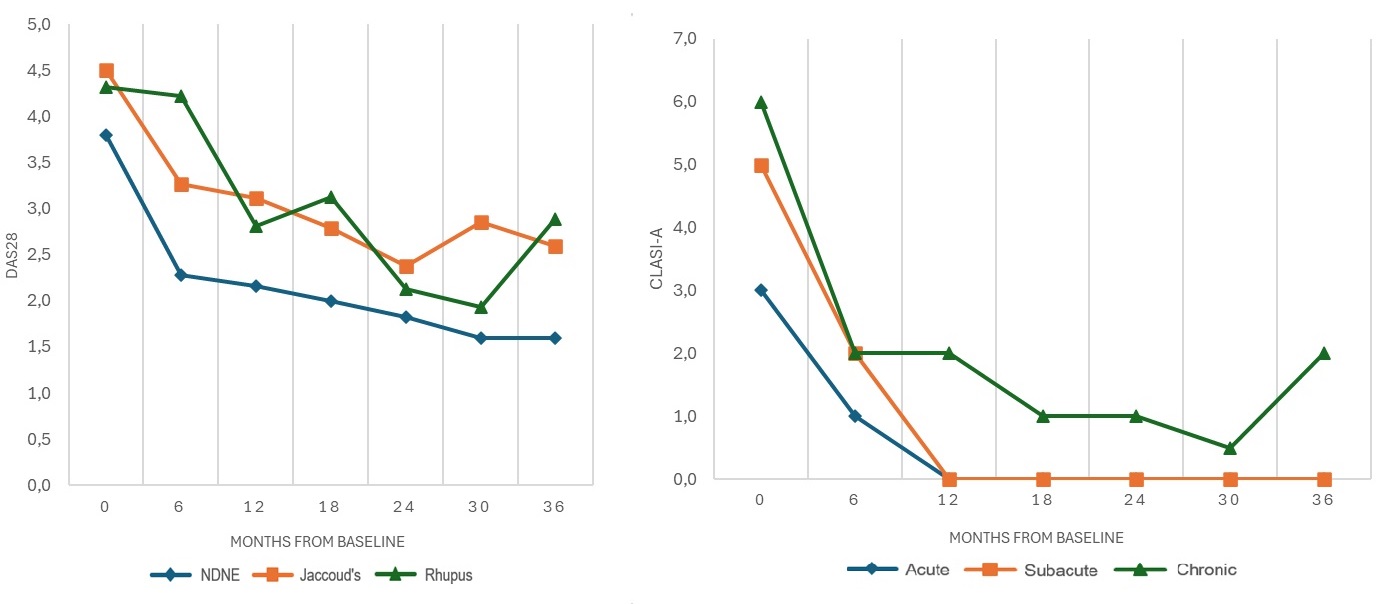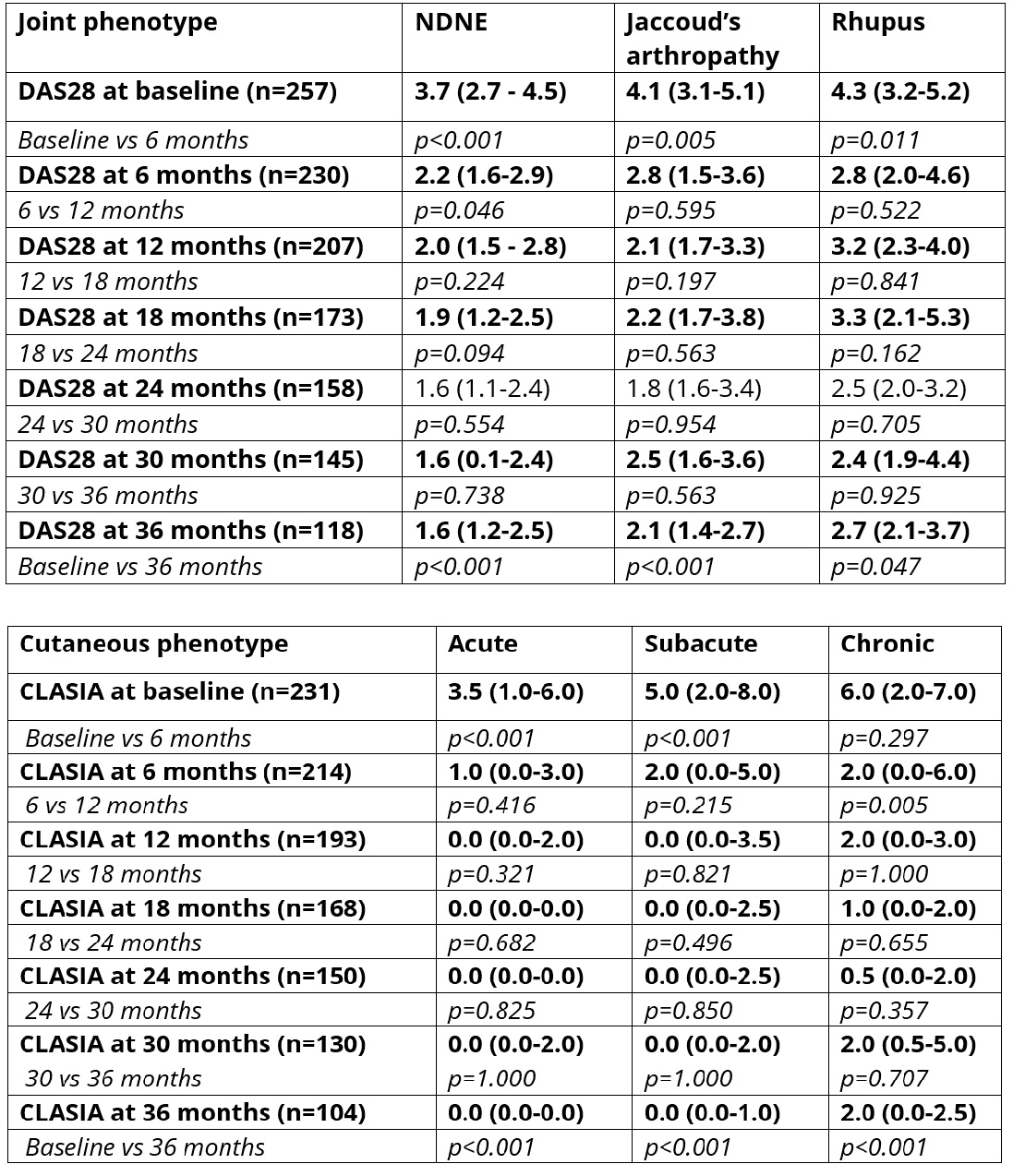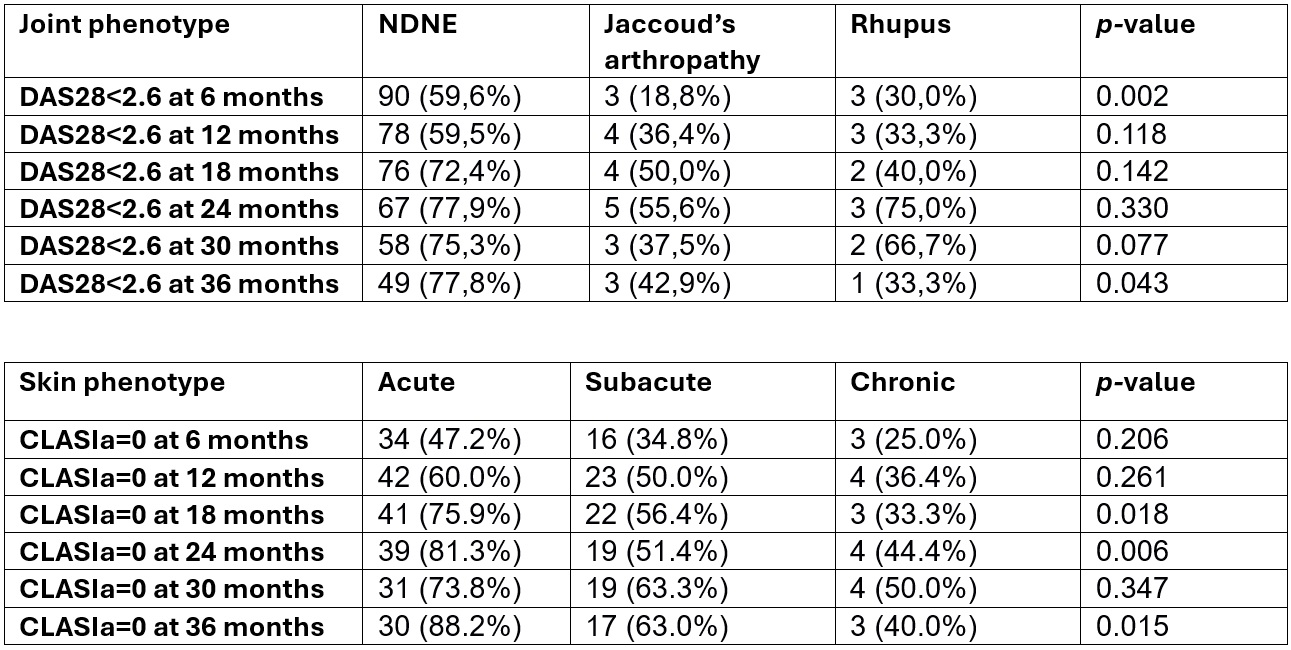Session Information
Date: Sunday, November 17, 2024
Title: SLE – Treatment Poster II
Session Type: Poster Session B
Session Time: 10:30AM-12:30PM
Background/Purpose: To evaluate the efficacy of belimumab on different skin and joint manifestations of the disease in a multicenter, nationwide, cohort (BeRLISS-NeJS) of patients with systemic lupus erythematosus (SLE).
Methods: In this retrospective observational study, we stratified adult SLE patients treated with belimumab (10 mg/kg/month EV or 200 mg/week SC) based on the joint (nondeforming non-erosive arthritis -NDNE-, Jaccoud’s arthropathy and rhupus) and skin phenotype (acute, subacute, chronic, cutaneous vasculitis, alopecia/lupus hair livedo reticularis) at belimumab initiation. We analyzed the variation of DAS28, CLASI-A, CLASI-D scores, achievment of DAS28 remission (DAS28< 2.6) and CLASI-A remission (CLASI-A=0) at baseline, 12, 24, 36 months of follow-up. Parametric and nonparametric tests were used according to the data distribution.
Results: A total of 443 patients was enrolled (F=394; 88.9%); mean age at diagnosis 29.9±13.2 years, mean treatment duration 31.6±20.8 months. At belimumab initiation 272 patients had joint manifestations (61.4%): 221 NDNE (50.7%), 30 Jaccoud’s arthropathy (6.9%) and 21 rhupus (4.8%); 231 patients (52.1%) had skin manifestations: 112 acute (25.9%), 54 subacute (12.5%) and 18 chronic cutaneous lupus (4.2%), 48 cutaneous vasculitis (11.1%), 23 livedo reticularis (5.3%), 79 alopecia/lupus hair (18.2%).
DAS28 and CLASI-A scores decreased from baseline at 12, 24, and 36 months in all phenotypes (Figure 1).
A statistically significant decrease in DAS28 compared with baseline was observable at 6 months for NDNE (p< 0.001), Jaccoud’s arthropathy (p=0.005) and rhupus (p=0.011). Significant further improvement of DAS28 in patients with NDNE was also observable when comparing DAS28 at 6 vs 12 months (p=0.046) (Table 1).
A statistically significant decrease in CLASI-A from baseline was observed as early as 6 months for the acute (p< 0.001) and subacute phenotype (p< 0.001), as late as 12 months for the chronic one (0-6 months p = 0.297, 0-12 months p=0.003, data not shown) and as late as 18 months for livedo reticularis (0-12 months p=0,066, 0-18 months p=0,027, data not shown) (Table 1). No significant decrease in CLASI-A was found for the other nonspecific skin manifestations of SLE.
CLASI-D scores remained stable at 36 months compared with baseline for all specific skin phenotypes (p=0.508, p=1.000, p=0.770, respectively).
DAS28 remission was more frequent in patients with NDNE than Jaccous’s and rhupus subtype at 6 and 36 months; on the other hand, CLASI-A remission was more frequent in patients with acute than subacute and chronic phenotype at 18, 24 and 36 months (Table 2).
Conclusion: Belimumab was effective at reducing joint involvement activity with significant decrease in DAS28 being observable as early as 6 months from treatment start across all joint phenotypes. Significant CLASI-A reduction was achieved later (12 months) in patients with chronic skin involvement than those with acute and subactute phenotypes. CLASI-D stability hints at a lessened damage accrual over the span of 36 months across all skin specific phenotypes. Patients with NDNE arthritis and acute skin subtype achieve more frequently DAS28 and CLASI-A remission than those with other phenotypes.
To cite this abstract in AMA style:
Iaccarino L, Bracalenti M, Cauli A, Cavagna L, De Angelis R, Depascale R, Emmi G, Gerli R, Govoni M, Lo Gullo A, Negrini S, Quartuccio L, Rossini M, Salvarani C, Tomietto P, Vacca A, Zen M, Andrea d. Efficacy of Belimumab on Different Phenotypes of Joint and Skin Manifestations of Systemic Lupus Erythematosus: Preliminary Data from a Multicenter, Nationwide, Cohort of Patients: The BElimumab in Real Life Setting Study-New Joint and Skin (BeRLISS-NeJS) [abstract]. Arthritis Rheumatol. 2024; 76 (suppl 9). https://acrabstracts.org/abstract/efficacy-of-belimumab-on-different-phenotypes-of-joint-and-skin-manifestations-of-systemic-lupus-erythematosus-preliminary-data-from-a-multicenter-nationwide-cohort-of-patients-the-belimumab-in-re/. Accessed .« Back to ACR Convergence 2024
ACR Meeting Abstracts - https://acrabstracts.org/abstract/efficacy-of-belimumab-on-different-phenotypes-of-joint-and-skin-manifestations-of-systemic-lupus-erythematosus-preliminary-data-from-a-multicenter-nationwide-cohort-of-patients-the-belimumab-in-re/



